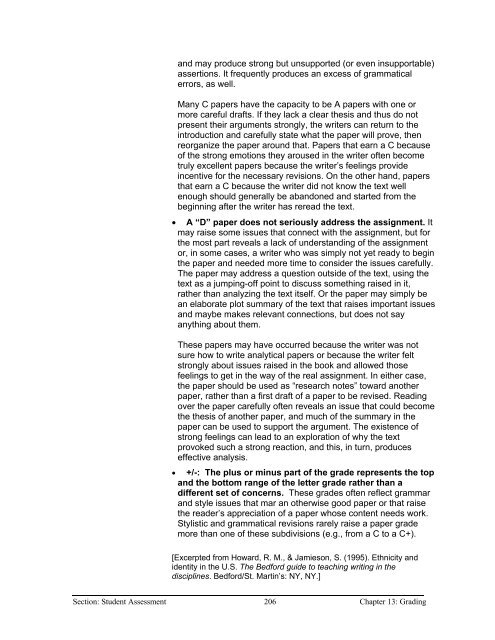Chapter 9 - Instructional Media: Chalkboards to Video - CGISS
Chapter 9 - Instructional Media: Chalkboards to Video - CGISS
Chapter 9 - Instructional Media: Chalkboards to Video - CGISS
You also want an ePaper? Increase the reach of your titles
YUMPU automatically turns print PDFs into web optimized ePapers that Google loves.
and may produce strong but unsupported (or even insupportable)<br />
assertions. It frequently produces an excess of grammatical<br />
errors, as well.<br />
Many C papers have the capacity <strong>to</strong> be A papers with one or<br />
more careful drafts. If they lack a clear thesis and thus do not<br />
present their arguments strongly, the writers can return <strong>to</strong> the<br />
introduction and carefully state what the paper will prove, then<br />
reorganize the paper around that. Papers that earn a C because<br />
of the strong emotions they aroused in the writer often become<br />
truly excellent papers because the writer’s feelings provide<br />
incentive for the necessary revisions. On the other hand, papers<br />
that earn a C because the writer did not know the text well<br />
enough should generally be abandoned and started from the<br />
beginning after the writer has reread the text.<br />
• A “D” paper does not seriously address the assignment. It<br />
may raise some issues that connect with the assignment, but for<br />
the most part reveals a lack of understanding of the assignment<br />
or, in some cases, a writer who was simply not yet ready <strong>to</strong> begin<br />
the paper and needed more time <strong>to</strong> consider the issues carefully.<br />
The paper may address a question outside of the text, using the<br />
text as a jumping-off point <strong>to</strong> discuss something raised in it,<br />
rather than analyzing the text itself. Or the paper may simply be<br />
an elaborate plot summary of the text that raises important issues<br />
and maybe makes relevant connections, but does not say<br />
anything about them.<br />
These papers may have occurred because the writer was not<br />
sure how <strong>to</strong> write analytical papers or because the writer felt<br />
strongly about issues raised in the book and allowed those<br />
feelings <strong>to</strong> get in the way of the real assignment. In either case,<br />
the paper should be used as “research notes” <strong>to</strong>ward another<br />
paper, rather than a first draft of a paper <strong>to</strong> be revised. Reading<br />
over the paper carefully often reveals an issue that could become<br />
the thesis of another paper, and much of the summary in the<br />
paper can be used <strong>to</strong> support the argument. The existence of<br />
strong feelings can lead <strong>to</strong> an exploration of why the text<br />
provoked such a strong reaction, and this, in turn, produces<br />
effective analysis.<br />
• +/-: The plus or minus part of the grade represents the <strong>to</strong>p<br />
and the bot<strong>to</strong>m range of the letter grade rather than a<br />
different set of concerns. These grades often reflect grammar<br />
and style issues that mar an otherwise good paper or that raise<br />
the reader’s appreciation of a paper whose content needs work.<br />
Stylistic and grammatical revisions rarely raise a paper grade<br />
more than one of these subdivisions (e.g., from a C <strong>to</strong> a C+).<br />
[Excerpted from Howard, R. M., & Jamieson, S. (1995). Ethnicity and<br />
identity in the U.S. The Bedford guide <strong>to</strong> teaching writing in the<br />
disciplines. Bedford/St. Martin’s: NY, NY.]<br />
Section: Student Assessment 206 <strong>Chapter</strong> 13: Grading
















